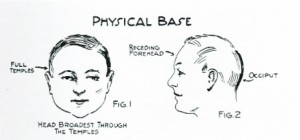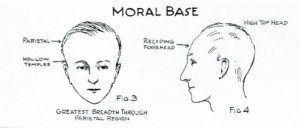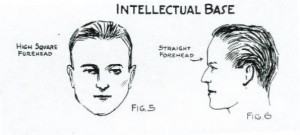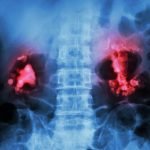Havard and Basic Diagnosis
Phrenology
Sussanna Czeranko, ND, BBE
Did you ever inquire why two individuals living under identically the same conditions will contract different diseases?
William Freeman Havard, 1919a, p. 379Diagnosis is nine points of healing; the application of therapeutic measures constitutes only one point. If the diagnosis is accurate, the therapeutic problem solves itself.
William Freeman Havard, 1915, p. 433The problem even in Naturopathy is to find out where to break into the “vicious circle.” Remedial measures there are in plenty, but the question is, which to use first and how to use it.
William Freeman Havard, 1920c, p. 179
One physician who saw value in the work of the phrenologists was William Freeman Havard. He studied and assimilated the findings of the phrenologists, devising eventually a practical approach to individualized healthcare management. While early NDs were striving to establish protocols and the essential elements of naturopathic practice, Havard was focusing on formulating a theory of one of the most critical aspects of practice, namely, diagnosis. Just as the clarity of his writings offered indispensable and essential tools for physicians a century ago, they stand up substantially for us today. It can be valuable, then, for us to explore Dr Havard’s insightful and practical theories. He developed diagnostic tools that incorporated head morphology and temperament, creating a systematic order for therapeutic interpretation and implementation.
It can be particularly rewarding for the modern physician to become familiar with William Freeman Havard, an almost forgotten ND who practiced in Illinois a century ago. Havard was keen to share his new diagnostic tool that he called “basic diagnosis.” He published many articles under this heading in The Herald of Health and Naturopath espousing his theory and demonstrating its implementation with case studies. He introduced basic diagnosis as a model that “relates body functions to mind functions and outlines an easy method of determining an individual’s predisposition toward disease” (Havard, 1919a, pp. 379-380). There was an order and definite laws governing this new diagnostic method. Basic diagnosis was “founded upon physiological and psychological laws and for the first time lays down the laws governing pathological sequence” (Havard, 1919a, p. 380).
What distinguished NDs from their allopathic colleagues were their therapeutic principles enabling them to view every patient as unique and to treat the whole person rather than the disease. From their perspective, no amount of analysis would arrive at a correct treatment plan if the physician ignored the uniqueness of the patient:
All our elaborate classification of symptoms, our blood analysis, urinary analysis, X-ray photography, diagnosis from the eye and all features of symptomatic diagnosis are valueless in enabling us to map out the correct treatment of a case if we overlook the individual factor or what has been termed the “personal equation.” (Havard, 1915, p. 433)
The personal equation, or the uniqueness of a patient, was included in Havard’s model. He cited that “there are only three primary functions necessary to the maintenance of life: digestion, breath and reproduction” (Havard, 1919a, p. 380). He continued: “Each of the three fundamental functions is related to one of the three Basic Principles of man, the digestion to the physical principle, the breath to the mental principle, and reproduction to the moral principle” (Havard, 1919a, p. 380). He reasoned that the body “must breathe and feed, and in order to be assured perpetuity it must reproduce” (Havard, 1919, p. 380). With this schema, he extrapolated that each person was a compilation of the three basic principles, physical, moral, and mental. Individuality, he explained, was “that no two persons have exactly the same mixture of these three basic principles” (Havard, 1919a, p. 380). As Havard wrote, that is “why one person grows fat on a certain diet and another gets thin on the same food” (1919a, p. 379).
Primary Principles
To assess the uniqueness of each patient, the phrenologists of the 19th and early 20th centuries devised skull maps to demarcate the various faculties or personality traits corresponding to the shape of the skull. Havard went one step further, using skull shapes to establish a method for diagnosis of functional strengths and weaknesses. Determining that there were three primary principles (physical, moral, and mental), he evolved a theory using these and relating them to a section in the cerebrum and a major organ system. Each of these principles was associated with specific areas of the brain: “[T]he physical principle is located in the occipito-temporal lobes, the moral in the parietal lobes, [and] the mental in the frontal lobes” (Havard, 1920c, p. 178). The physical principle ruled digestion, the moral principle was the domain of generative or reproductive organs and ductless glands, and the mental principle governed respiration: “The basic diagnosis is made in accordance with the degree of development existing in these brain areas as shown by the shape and conformity of the cranium” (Havard, 1920c, p. 178).
Physical Base
 Havard’s description of the physically based person is fascinating. He wrote: “The head of a physically based is broadest at the base, just above the ears, the temples are full and the occipital region well developed” (Havard, 1919d, p. 593). The forehead (site of the mental base) will be receded, and the top of the head may or may not be high in a physically based person (Havard, 1919d, p. 593). Havard established the liver as the primary organ of the digestive system, with “the mouth, alimentary canal, and pancreas merely acting as preparatory organs through whose action food products are fermented and rendered soluble and diffusible” (1919b, p. 483). The liver’s chief functions were to act as the body’s great chemical laboratory, assembling from food every metabolic need and preparing metabolic waste to be eliminated through the kidneys and skin (Havard, 1919b, p. 483).
Havard’s description of the physically based person is fascinating. He wrote: “The head of a physically based is broadest at the base, just above the ears, the temples are full and the occipital region well developed” (Havard, 1919d, p. 593). The forehead (site of the mental base) will be receded, and the top of the head may or may not be high in a physically based person (Havard, 1919d, p. 593). Havard established the liver as the primary organ of the digestive system, with “the mouth, alimentary canal, and pancreas merely acting as preparatory organs through whose action food products are fermented and rendered soluble and diffusible” (1919b, p. 483). The liver’s chief functions were to act as the body’s great chemical laboratory, assembling from food every metabolic need and preparing metabolic waste to be eliminated through the kidneys and skin (Havard, 1919b, p. 483).
His contention was that the physically based person had strong digestive functions, with the liver being the major organ that is central to the “organic operations [that] supplies the materials for cell growth and repair” (Havard, 1919c, p. 534). The distinguishing quality of the physically based person is his or her dependence on food. Havard continued: “He likes big meals at regular intervals but is not very particular about the quality or the combination of the dishes. In fact, he has a preference for the coarser foods. His digestion [is] excellent” (1919d, p. 594). Overall, the temperament of the physically based person is that she or he is “more in harmony with nature and . . . lives a more simple and uncomplicated existence. He is more likely to be hardy and physically strong” (Havard, 1919c, p. 534).
Moral Base
 Havard’s description of the morally based person depicts a different topography. He wrote: “The morally based person presents a receding forehead, high top-head, hollow temples with the greatest development in the parietal region” (Havard, 1919d, p. 595). This profile indicates that the generative or reproductive organs and the ductless glands (or endocrine system) are the strongest organs and the last to become affected by a disease process (Havard, 1919c, p. 535).
Havard’s description of the morally based person depicts a different topography. He wrote: “The morally based person presents a receding forehead, high top-head, hollow temples with the greatest development in the parietal region” (Havard, 1919d, p. 595). This profile indicates that the generative or reproductive organs and the ductless glands (or endocrine system) are the strongest organs and the last to become affected by a disease process (Havard, 1919c, p. 535).
He added: “This principle governs morality, spirituality, imagination, music, art, poetry, invention and . . . an appreciation of religion and infinity” (Havard, 1919c, p. 534). In addition, Havard explained:
Morally based individuals are guided largely by their feelings, sentiments, affections and emotion. They are intuitive . . . rather than reasoning for an answer. . . . They are artistic, fond of society . . . and inclined to be moody. (1919d, p. 595)
They can be ruled by their emotions and have a nervous temperament inclined toward theoretical tendencies.
Mental Base
 There are two morphologies for the mentally based individual: “the small type with the high narrow forehead on which a perfect square can be drawn and the large type with the broad head whose forehead is rectangular” (Havard, 1919d, p. 596). The lungs are the basic organs of this system, dealing with oxygen metabolism and the elimination of carbon dioxide. But Havard construed that the lungs did much more than process oxygen and carbon dioxide. In fact, the “breath is the expression for life and generates the force which sets into vibration every atom of the physical organism” (Havard, 1919b, p. 483).
There are two morphologies for the mentally based individual: “the small type with the high narrow forehead on which a perfect square can be drawn and the large type with the broad head whose forehead is rectangular” (Havard, 1919d, p. 596). The lungs are the basic organs of this system, dealing with oxygen metabolism and the elimination of carbon dioxide. But Havard construed that the lungs did much more than process oxygen and carbon dioxide. In fact, the “breath is the expression for life and generates the force which sets into vibration every atom of the physical organism” (Havard, 1919b, p. 483).
In his view, “oxygen is necessary in the body to support combustion, which takes place in every individual cell, and to promote metabolism” (Havard, 1919b, p. 482). The delivery of oxygen is via the blood circulatory system, which he explained was “secondary to all three of the primary organ systems” (Havard, 1919b, p. 482).
Havard’s depictions of the details of phrenology were quite substantial. Among other observations, he wrote: “[A]ll the faculties of reason, logic, judgment, discrimination, deduction, calculation and memory of facts are presided over by the mental principle which operates through the frontal lobes of the cerebrum” (Havard, 1919c, p. 537). Furthermore, he noted:
[M]entally based persons are guided by their reasoning powers. They are cool and calculating, demanding mathematical exactness in all dealings. . . . They do better work and accomplish more when left to work on their own initiative than when under the direction of others. (Havard, 1919d, p. 596)
In addition, Havard reminded us that “the Mental or Intellectual Principle . . . and its activities are supported by the action of the upper lobes of the lungs” (1919c, p. 535). He wrote:
[T]he lungs by their rhythmic action, collect from out of the etheric domain the electric energy which, when transformed and transmitted through the body, supplies the spark of life to the cells. Breath is the basic principle of life and the lungs its mainsprings. (Havard, 1919c, p. 535)
Why and how we get sick was carefully addressed by Havard’s model of basic diagnosis and the pathological sequence. He continued:
“[T]he principles of Naturopathy show us that disease is a process, and that while the primary cause is uniformly the same in each case, the manifestation will vary in accordance with the temperament of the individual” (Havard, 1920c, p. 179). Indeed, accurate diagnosis was essential if correct treatment plans were to be implemented. The theory of pathological sequence was Havard’s attempt to simplify and clarify the steps to successful practice. Havard declared: “The successful physician is the one who can analyze a patient and his conclusion at a glance.” (Havard, 1915, 433) He continued: “There are absolute laws and rules that can be applied in order to determine, beyond the shadow of a doubt, where the seat of disease is in any individual” (Havard, 1915, p. 433).
Using skull morphology and assessing each of the three areas in prominence, Havard eventually created a three-tier model. The model enables us to understand and explain how to begin in diagnostic evaluations.
Base and Inclinations
Havard’s body of writing is substantial. Often synthesizing observation and analysis, he would sprinkle his work with clinical pearls. For example, he asserted: “Basic Diagnosis throws a clearer light on both physiology and pathology, because it bases its conclusions and deductions on the relative degree of functional activity existing in the different organ systems of the individual” (Havard, 1919a, p. 380). Having three principles to work with, Havard considered the base to be the area of greatest development and most prominent feature of a person’s skull. He made it clear, for example, that “the skull conforms to the shape of the brain and accommodates itself to cerebral development, and consequently the contour of the head will be our guide in determining the relative degree of development in the several cerebral lobes” (Havard, 1919d, p. 593).
He established that the base organ “corresponding to the basic principle, is the strongest organ system in the body. It is the body’s main support and the last to be diseased” (Havard, 1920c, p. 178). The weakest organ, “corresponding to the second inclination, is the first to show signs of weakness and is the point at which a disease process starts” (Havard, 1920c, p. 178). Using the “inclination” terminology, he continued to define these three levels of principles, noting that “the organ corresponding to the first inclination shows the most acute symptoms and is the organ selected to handle acute reactions” (Havard, 1920c, p. 178). The order of disease progression always “starts in the organs of the weaker inclination, never in those of the stronger inclination or those of the base” (Havard, 1920b, p. 123).
Havard elaborated frequently on the pathological sequence, which began with the organs of the second inclination showing signs of weakness and “throwing a greater burden upon the organs of the stronger inclination” (1920b, p. 123). If the dysfunction of the second inclination is not corrected, then a domino effect occurs, and the first inclination and the organs of the base “may become weakened and demand compensation from the basic organ” (Havard, 1920b, p. 123).
Case Study
A case presented by Havard:
Case: Male, age 30 years; 5′ 6″; 130 lb.
Chief complaint: Chronic nasal catarrh with recurrent acute bronchitis, severe headaches, and constipation.
Basic diagnosis: Base is moral (reproductive system), first inclination is intellectual (respiratory system), and second inclination is physical (digestive system).
Personal history: He was vaccinated at age 2 years. He had measles twice and scarlet fever (followed by chicken pox) by the time he was 6. At age 7, bilious attacks, followed by diarrhea and pneumonia. Treated with homeopathy; excessive eating resulted in chronic bronchitis. Had typhoid fever at age 18. Allopathic treatment to treat diarrhea with opiates resulted in constipation for 4 weeks. Following year, tuberculosis was suspected, and osteopathy and neuropathy were tried. Respiratory symptoms improved slightly, but severe headaches began with bilious attacks and respiratory symptoms returned (Havard, 1920a, p. 67).
Interpretation: The acute conditions in childhood (scarlet fever, chicken pox) were “natural reactions with skin elimination for the purpose of cleansing the body of hereditary taints and the vaccine” (Havard, 1920a, p. 68). These cleansing reactions were not successful, and the patient developed bilious attacks affecting his weakest organ, the liver. The diarrhea was the digestive tract alleviating the excess waste, and the opiates suppressed and blocked the normal channels of elimination.
In response, Havard’s naturopathic treatment was the following:
[T]o build up compensation in the generative system. . . . Sitz baths, and sun baths to the pelvic region were given to tone up these organs and improve the circulation to them. The tired, overworked digestive organs demanded rest . . . frequent short fasts were instituted together with colon irrigation. The diet between fasts was almost entirely eliminative, consisting entirely of either fruits or vegetables. The headaches . . . were relieved by colon irrigation. . . . Baths were given first hot to increase skin activity and elimination. Later on cold bathing was instituted as a general tonic. The patient adopted a low protein vegetarian diet as habit of life, eating as a rule two meals a day. Very little symptomatic treatment was given for the respiratory trouble as it was realized that [as] the liver and digestive organs caught up . . . the catarrhal elimination from the respiratory tract would subside. (Havard, 1920a, p. 69)
The curative process, in Havard’s view, was only possible if the environment of the cells could be brought back to normal. Before propounding his theory of basic diagnosis, Havard had written: “Nature Cure adopted a curative procedure to be followed out with every case, beginning with measures for promoting elimination and following them up with strengthening measures for raising the patient’s resistive power” (1920c, p. 179). Havard’s new theory assured individualization to the patient care. “Treat the whole person, not the symptoms” (tolle totum or tolle causam) was a core philosophical and theoretical position adopted early by the emerging naturopathic profession. The individualizing of healthcare is considered today absolutely core to naturopathic philosophy and practice. Havard evolved a model for us that, on close examination, can renew our confidence in the medicine of our elders and may spark curiosity, renewed interest, and clinical success.

Sussanna Czeranko, ND, BBE is a licensed naturopathic physician in Ontario and Oregon and is a faculty member working as the rare books curator at National College of Naturopathic Medicine (Portland, Oregon). She is currently compiling an 11-book series based on the journals published early in the last century by Benedict Lust. In addition to her work in balneotherapy, she is founder of the Breathing Academy, a training institute for physicians to incorporate a scientific model of breathing therapy called buteyko into their practice.
References
Havard, W. F. (1915). The accurate diagnosis. The Naturopath and Herald of Health, 20(7), 431-433.
Havard, W. F. (1919a). A course in basic diagnosis: Introduction. Herald of Health and Naturopath, 24(8), 379-381.
Havard, W. F. (1919b). A course in basic diagnosis: The primary organ systems. Herald of Health and Naturopath, 24(10), 482-486.
Havard, W. F. (1919c). A course in basic diagnosis: Basic principles. Herald of Health and Naturopath, 24(11), 534-538.
Havard, W. F. (1919d). A course in basic diagnosis: Determination of base and inclinations. Herald of Health and Naturopath, 24(12), 593-597.
Havard, W. F. (1920a). A course in basic diagnosis: Pathological sequence. Herald of Health and Naturopath, 25(2), 67-69.
Havard, W. F. (1920b). A course in basic diagnosis: Suppression of gonorrhea resulting in tuberculosis. Herald of Health and Naturopath, 25(3), 122-124.
Havard, W. F. (1920c). A course in basic diagnosis: Summary. Herald of Health and Naturopath, 25(4), 178-180.









